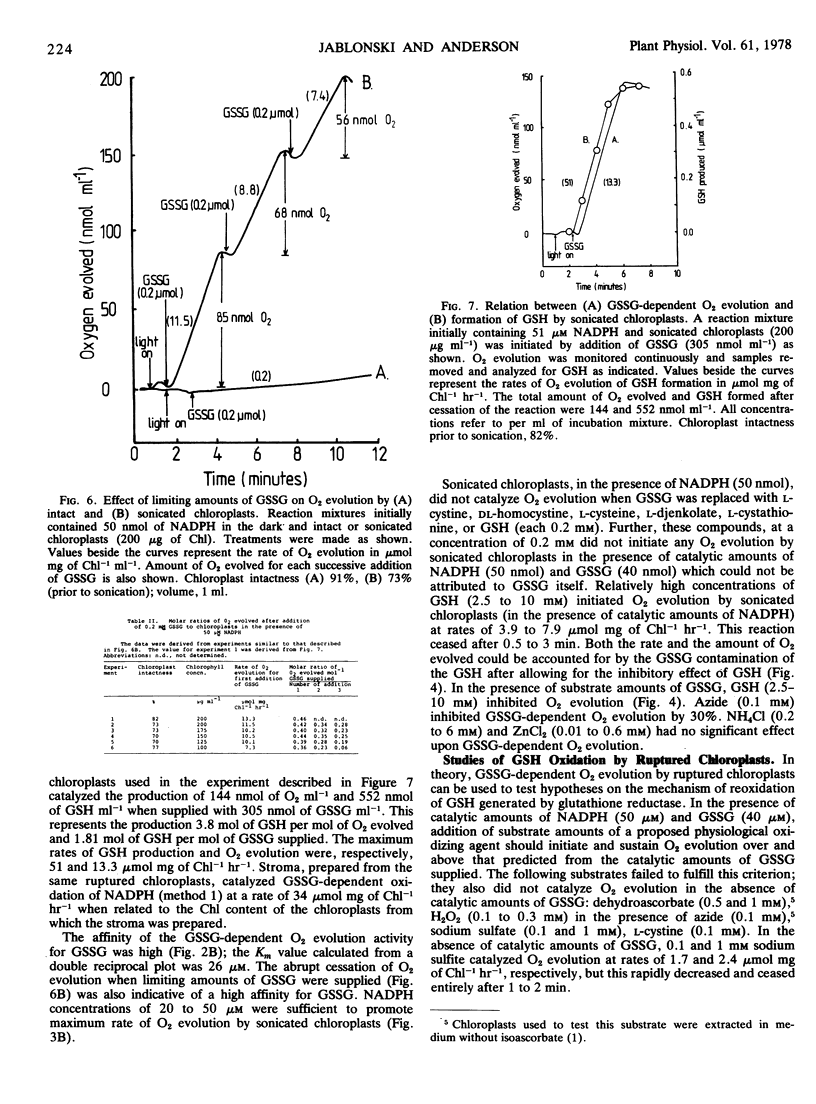Abstract
Crude extracts of pea shoots (Pisum sativum) catalyzed oxidized glutathione (GSSG)-dependent oxidation of NADPH which was attributed to NADPH-specific glutathione reductase. The pH optimum was 8 and the Km values for GSSG and NADPH were 23 μm and 4.9 μm, respectively. Reduced glutathione (GSH) inhibited the reaction. Crude extracts also catalyzed NADPH-dependent reduction of GSSG; the ratio of the rate of NADPH oxidized to GSH formed was 0.49. NADH and various substituted mono- and disulfides would not substitute for NADPH and GSSG respectively. Per mg of chlorophyll, enzyme activity of isolated chloroplasts was 69% of the activity of crude extracts.
Illuminated sonicated pea chloroplasts, in the presence of catalytic amounts of NADPH, catalyzed GSSG-dependent O2 evolution (mean of 10 determinations, 10.4 μmol per mg chlorophyll per hour, sd 1.4) with the concomitant production of GSH. The molar ratio of GSH produced to O2 evolved was 3.8 and the highest ratios for O2 evolved to GSSG added were 0.46 and 0.44. The Km value for GSSG was 26 μm. GSH inhibited the reaction. The reaction was attributed to photosynthetically coupled glutathione reductase.
Ruptured chloroplasts, in the presence of catalytic amounts of GSSG and NADPH, did not catalyze sustained O2 evolution in the presence of substrate amounts of hydrogen peroxide, dehydroascorbate, l-cystine, sulfite, or sulfate.
Full text
PDF




Selected References
These references are in PubMed. This may not be the complete list of references from this article.
- Anderson J. W., Done J. A polarographic study of glutamate synthase activity in isolated chloroplasts. Plant Physiol. 1977 Sep;60(3):354–359. doi: 10.1104/pp.60.3.354. [DOI] [PMC free article] [PubMed] [Google Scholar]
- Asada K., Kiso K., Yoshikawa K. Univalent reduction of molecular oxygen by spinach chloroplasts on illumination. J Biol Chem. 1974 Apr 10;249(7):2175–2181. [PubMed] [Google Scholar]
- ELLMAN G. L. The biuret reaction: changes in the ultraviolet absorption spectra and its application to the determination of peptide bonds. Anal Biochem. 1962 Jan;3:40–48. doi: 10.1016/0003-2697(62)90042-8. [DOI] [PubMed] [Google Scholar]
- ELLMAN G. L. Tissue sulfhydryl groups. Arch Biochem Biophys. 1959 May;82(1):70–77. doi: 10.1016/0003-9861(59)90090-6. [DOI] [PubMed] [Google Scholar]
- HENDLEY D. D., CONN E. E. Enzymatic reduction and oxidation of glutathione by illuminated chloroplasts. Arch Biochem Biophys. 1953 Oct;46(2):454–464. doi: 10.1016/0003-9861(53)90216-1. [DOI] [PubMed] [Google Scholar]
- Hafeman D. G., Sunde R. A., Hoekstra W. G. Effect of dietary selenium on erythrocyte and liver glutathione peroxidase in the rat. J Nutr. 1974 May;104(5):580–587. doi: 10.1093/jn/104.5.580. [DOI] [PubMed] [Google Scholar]
- MAPSON L. W., ISHERWOOD F. A. Glutathione reductase from germinated peas. Biochem J. 1963 Jan;86:173–191. doi: 10.1042/bj0860173. [DOI] [PMC free article] [PubMed] [Google Scholar]
- Robinson S. P., Wiskich J. T. Stimulation of carbon dioxide fixation in isolated pea chloroplasts by catalytic amounts of adenine nucleotides. Plant Physiol. 1976 Aug;58(2):156–162. doi: 10.1104/pp.58.2.156. [DOI] [PMC free article] [PubMed] [Google Scholar]
- SCOTT E. M., DUNCAN I. W., EKSTRAND V. PURIFICATION AND PROPERTIES OF GLUTATHIONE REDUCTASE OF HUMAN ERYTHROCYTES. J Biol Chem. 1963 Dec;238:3928–3933. [PubMed] [Google Scholar]
- Schaedle M. Chloroplast glutathione reductase. Plant Physiol. 1977 May;59(5):1011–1012. doi: 10.1104/pp.59.5.1011. [DOI] [PMC free article] [PubMed] [Google Scholar]
- Stadtman T. C. Selenium biochemistry. Science. 1974 Mar 8;183(4128):915–922. doi: 10.1126/science.183.4128.915. [DOI] [PubMed] [Google Scholar]
- Young L. C., Conn E. E. The Reduction and Oxidation of Glutathione by Plant Mitochondria. Plant Physiol. 1956 May;31(3):205–211. doi: 10.1104/pp.31.3.205. [DOI] [PMC free article] [PubMed] [Google Scholar]


